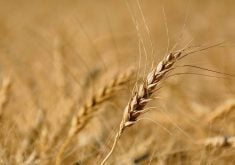Canada’s Western Red Spring wheat, this country’s flagship wheat that is famous for its bread-making quality, is accustomed to having the spotlight all to itself.
But lately two of its siblings — Canada Prairie Spring (CPS) and Canada Western Red Winter classes of wheat have been earning quite a name for themselves with buyers.
Interest is growing because CPS red “makes an excellent loaf of bread… particularly the new varieties,” the Canadian Grain Commission’s David Hatcher told the Manitoba Seed Growers’ Association’s annual meeting Dec. 11.
Read Also

Manitoba sclerotinia picture mixed for 2025
Variations in weather and crop development in this year’s Manitoba canola fields make blanket sclerotinia outlooks hard to pin down
Hatcher, program manager of the Asian Products and Wheat Enzymes Crops Section of the CGC’s Grain Research Laboratory, visited a number of Asian cities in the fall to brief Canadian wheat customers on the quality of the 2014 crop.
“After every seminar customers were asking me about where can I get some CPS wheat (and) what varieties do you suggest? There was a lot of interest there,” Hatcher said.
The CPS class was established in 1985 for wheats with medium protein, medium kernel hardness and medium dough strength relative to CWRS wheat. In the early years CPS wheats were generally higher yielding too, which offset the lower return relative to CWRS.
Now there are some very good quality milling wheats in the CPS class, Hatcher said. Not only does CPS wheat make good loaves of bread, it is well suited for noodles and steam breads, which are popular in Asia, Hatcher said.
The same holds for wheats in the Canada Western Red Winter class. The milling quality in that class has improved too, thanks in part to moving CDC Falcon to the Canada Western General Purpose class.
CGC chief commissioner Elwin Hermanson said some years CDC Falcon made milling quality, but most years it didn’t, undermining the whole CWRW class.
An open Canadian market might also result in CPS gaining more popularity among western Canadian farmers, Hermanson said. When it had a sales monopoly, the Canadian Wheat Board focused on selling CWRS and Canada Western Amber durum (CWAD) wheat “and was good at it,” he said.
CWRS and CWAD account for the vast majority of western Canadian wheat exports.
But in recent years the sale of some minor wheat classes has doubled, Hermanson said.
“From a layman’s point of view that tells me there’s potential,” he said. “They may start out as niche markets. I think there is opportunity and growing interest.”
In the short term there won’t be large sales of CPS or CWRW wheat, but small or new grain companies might be able to earn premiums shipping those wheats in containers, Hermanson said.
“If we can give them what they want year after year — and we’re known for that — there is opportunity,” he said.
Seed grower Eric McLean said growers are uneasy about producing seed for a market when they don’t know how much demand there will be. Hatcher acknowledged there’s a catch-22 — farmers can’t sell a product they don’t have, but farmers are reluctant to grow something until they know there’s a market.
“All I can tell you is the market is calling for it,” Hatcher said.
CPS wheats may have had a yield advantage in the past, but Manitoba crop insurance data shows that’s no longer so. The five-year provincial average (2013-09) yield for CPS wheat was 44 bushels an acre compared to 49 for CWRS.
In four of those five years, CWRS yielded more than CPS, except in 2011 when they tied.
Moreover, during that period average CWRS yields exceeded 48 bushels an acre three out of five years; CPS wheat did it just one year.
CPS wheat hasn’t been popular with Manitoba farmers. During that period, on average just 33 Manitoba farms grew just under 8,600 acres a year.
In contrast, an average 7,900 farmers grew 2.25 million acres of CWRS wheat.
CPS wheat hasn’t attracted much interest in Manitoba, but that’s not the case for “feed wheat,” which under crop insurance collection includes unregistered wheats and those in the Canada Western General Purpose (CWGP) class.
In 2013 Manitobans grew almost 134,000 acres of feed wheat — triple the 2012 and the 10-year average of 46,041 and 40,590 acres.
The 2013 provincial average feed wheat yield was 77 bushels an acre, shattering the previous record of 58 bushels set in 2003.
In the Rural Municipality of Woodlands, just north of Winnipeg, Pasteur, which is in the CWGP class, averaged 99 bushels an acre in 2013 on almost 1,300 acres.




















